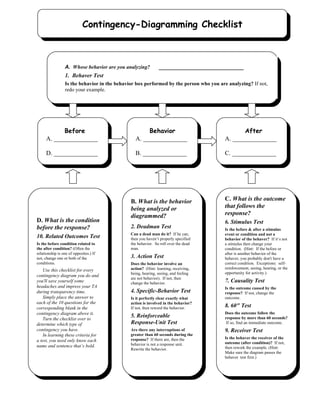
5. pink sheet checklist
- 1. Contingency-Diagramming Checklist A. Whose behavior are you analyzing? ___________________________ 1. Behaver Test Is the behavior in the behavior box performed by the person who you are analyzing? If not, redo your example. Before Behavior After A. ______________ A. ______________ A. ______________ D. ______________ B. ______________ C. ______________ B. What is the behavior C. What is the outcome being analyzed or that follows the diagrammed? response? D. What is the condition 6. Stimulus Test before the response? 2. Deadman Test Is the before & after a stimulus Can a dead man do it? If he can, event or condition and not a 10. Related Outcomes Test then you haven’t properly specified behavior of the behaver? If it’s not Is the before condition related to the behavior. So roll over the dead a stimulus then change your the after condition? (Often the man. condition. (Hint: If the before or relationship is one of opposites.) If after is another behavior of the not, change one or both of the 3. Action Test behaver, you probably don't have a conditions. Does the behavior involve an correct condition. Exceptions: self- action? (Hint: learning, receiving, reinforcement, seeing, hearing, or the Use this checklist for every being, hearing, seeing, and feeling opportunity for activity.) contingency diagram you do and are not behavior). If not, then you'll save yourself some change the behavior. 7. Causality Test headaches and impress your TA Is the outcome caused by the during transparency time. 4. Specific-Behavior Test response? If not, change the Simply place the answer to Is it perfectly clear exactly what outcome. each of the 10 questions for the action is involved in the behavior? corresponding blank in the If not, then reword the behavior. 8. 60" Test contingency diagram above it. Does the outcome follow the 5. Reinforceable response by more than 60 seconds? Turn the checklist over to determine which type of Response-Unit Test If so, find an immediate outcome. contingency you have. Are there any interruptions of 9. Receiver Test In learning these criteria for greater than 60 seconds during the response? If there are, then the Is the behaver the receiver of the a test, you need only know each outcome (after condition)? If not, name and sentence that’s bold. behavior is not a response unit. Rewrite the behavior. then rework the example. (Hint: Make sure the diagram passes the behaver test first.)
- 2. What type of contingency is it? Now that you have diagrammed the contingency according to the above criteria, it is time to determine what type of contingency you have. Use the following table to ensure correct identification of your contingency diagram. Contingency Table Basic Contingencies Prevention Contingencies Present Remove Prevent Presentation Prevent Removal Reinforcer Reinforcement by the Punishment by the Punishment by the Reinforcement by the presentation of a removal of a reinforcer prevention of a prevention of the reinforcer (Penalty) reinforcer removal of a reinforcer (Reinforcement) • Is the reinforcer • Does the response (Avoidance) • Is a reinforcer removed immediately prevent • Does the response presented immediately after the the presentation of a immediately prevent immediately after the response? reinforcer? the loss of (or response? • Is the removal of the • Is the prevention of removal of • Is the reinforcer reinforcer contingent the presentation of opportunity for) a contingent on the on the response? the reinforcer reinforcer? response? (Would (Would the contingent on the • Is the avoidance of the presentation of reinforcer still be response? (Would the loss of the the reinforcer still removed if the the presentation of reinforcer contingent occur if the behavior behavior did not the reinforcer still on the response? did not occur?) occur?) occur if the behavior (Would the • Will the frequency of • Will the frequency of did not occur?) reinforcer still be the response the response • Will the frequency of removed if the increase? decrease? the response behavior did not decrease? occur? • Will the frequency of the response increase? Aversive Condition Punishment by the Reinforcement by the Reinforcement by the Punishment by the presentation of an removal of an aversive prevention of the prevention of the aversive condition condition presentation of an removal of an aversive (Punishment) (Escape) aversive condition condition • Is an aversive • Is an aversive (Avoidance) • Does the response condition presented condition removed • Does the response immediately prevent immediately after the immediately after the immediately prevent the removal of an response? response? the presentation of an aversive condition? • Is the aversive • Is the removal of the aversive condition? • Is the prevention of condition contingent aversive condition • Is the avoidance of removal of the on the response? contingent on the the aversive aversive condition (Would the response? (Would condition contingent contingent on the presentation of the the aversive on the response? response? (Would aversive condition condition still be (Would the the aversive still occur if the removed if the presentation of the condition still be behavior did not behavior did not aversive condition removed if the occur?) occur?) sill occur if the behavior did occur?) • Will the frequency of • Will the frequency of behavior did not • Will the frequency of the response the response occur?) the response decrease? increase? • Will the frequency of decrease? the response increase? If the before and after conditions are the same (i.e., no stimulus is presented or removed) then your diagram is extinction or recovery. Note that although extinction and recovery are not technically contingencies, this Contingency-Diagramming Checklist can also be used to evaluate those diagrams.
